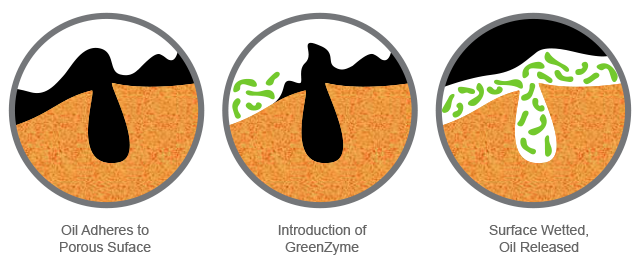The Technology Behind GreenZyme EEOR
Enzyme Enhanced Oil Recovery (EEOR)
Genetic Engineering
A special strain of naturally occurring microbe, which possesses hydrocarbon-reducing (oil-digesting) traits, is identified and selectively cultured. Next, a man-made, non-living protein that is highly soluble in water is created. GreenZyme is produced by a proprietary process which involves impregnating this water soluble high-protein solution with the DNA of the hydrocarbon-reducing microbe. The process renders nearly all of the living microbes inert. The resultant GreenZyme catalyst contains only non-living enzymes possessing the partial DNA of hydrocarbon-reducing microbes.
Hybrid DNA
GreenZyme inherits its attraction to hydrocarbon from the donor microbe, but because it is a non-living enzyme, it does not possess the donor microbe’s ability to consume hydrocarbon. From the donor protein, GreenZyme inherits wetting characteristics. The combination of these two characteristics results in a non-living enzyme that seeks out surface-bound hydrocarbons and releases them into the water column.
Catalytic Release
Crude oil adheres to the porous surface of sand and rock, effectively becoming trapped. GreenZyme enhances crude oil recovery by wetting the surface of the sand or rock at the molecular level. GreenZyme instantly transforms the adhesive surface of the sand or rock from a water-wetted surface, to a GreenZyme/water-wetted surface. The GreenZyme/water-wetted surface is dynamically oleophobic (lacking affinity for oils). The cohesive forces acting on the oil molecules are dramatically increased, causing the oil molecules to ball up and release from the sand or rock surface where they enter the water column and can be easily recovered. Once the oil has been released into the water column, GreenZyme moves on in search of more oil. This, coupled with the fact that GreenZyme is non-degrading and non-consumable, accounts for its lengthy activity cycle. As long as surface-bound hydrocarbons are present, GreenZyme will continue to seek them out and release them.

Environmental Tolerance
Because GreenZyme is a non-living, DNA-based catalyst it is unaffected by adverse environmental conditions occurring within the formation. GreenZyme is not affected by:
- Temperature, pH, or salinity
- Radioactive isotopes and NORM
- Metallic ions and sulfur
- Hydrogen sulphide content
- Paraffins, naphthatenes, or asphaltenes (at levels < 50%)
- Residual chemical and microbe EOR treatments

Contact NIXUS About GreenZyme
Discuss your project with an experienced petrochemical engineer and receive a custom GreenZyme EEOR solution.
GreenZyme Documents
GreenZyme Advantages
- Proven performance
- Superior to other EOR methods
- Simple application
- Expedient
- Environmentally safe
- Cost-efficient
GreenZyme Applications
- Waterflooding wells
- Single huff-and-puff wells
- Steam-injection wells
- Chemical fracturing wells
- Acid-treated and hot oil–treated wells
- Chemical EOR-treated wells
- Thermal extraction wells
- Sludge cleanup in tanks, containers, ships, and pipelines
- Oil spill and accident cleanup

 GreenZyme EEOR Overview
GreenZyme EEOR Overview